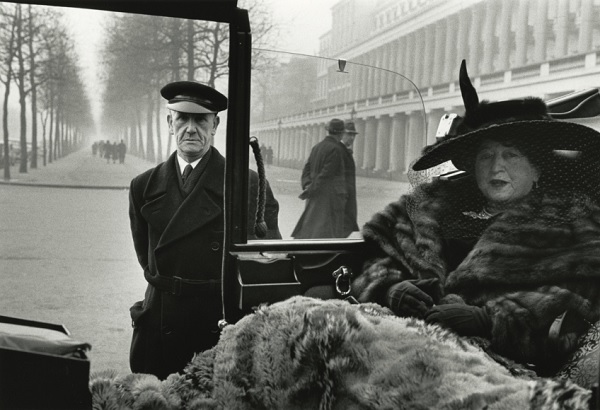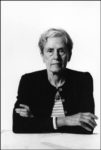
Inge Morath
American, b. Austria, 1923-2002
Publisher Eveleigh Nash, Buckingham Palace Mall, London, 1977
gelatin silver print
9 x 13 3/4 in.
SBMA, Gift of Arthur and Yolanda Steinman
1983.69.109.1

Inge Morath, London, 1997. © Rene Burri/Magnum Photos
“Photography is a strange phenomenon... You trust your eye and cannot help but bare your soul.” - Inge Morath
COMMENTS
After the Second World War, Morath worked as a translator and journalist. In 1948, she was hired by Warren Trabant, first as Vienna Correspondent and later as the Austrian editor, for Heute, an illustrated magazine published by the US Information Agency in Munich. Morath encountered photographer Ernst Haas in post-war Vienna, and brought his work to Trabant’s attention. Working together for Heute, Morath wrote articles to accompany Haas’ pictures. In 1949, Morath and Haas were invited by Robert Capa to join the newly-founded Magnum Photos in Paris, where she would work as an editor. Working with contact sheets sent into the Magnum office by founding member Henri Cartier-Bresson fascinated Morath. She wrote, “I think that in studying his way of photographing I learned how to photograph myself, before I ever took a camera into my hand.”
Morath was briefly married to the British journalist Lionel Birch and relocated to London in 1951. That same year, she began to photograph during a visit to Venice. “It was instantly clear to me that from now on I would be a photographer,” she wrote. “As I continued to photograph I became quite joyous. I knew that I could express the things I wanted to say by giving them form through my eyes.” Morath applied for an apprenticeship with Simon Guttman, who was at that time an editor for Picture Post and running the picture-agency Report. When Guttman demanded to know what Morath wanted to photograph, and why, she answered that “after the isolation of Nazism I felt I had found my language in photography.” After Morath had spent several months working as Guttman’s secretary, he finally set her to work. She sold her first photographs, of opening nights, exhibitions, inaugurations, etc., under the pseudonym Egni Tharom, her own name spelled backwards.
Morath divorced Birch and returned to Paris to pursue a career in photography. In 1953, Morath presented her first large picture story, on the Worker Priests of Paris, to Capa, and he invited her to join the agency as a photographer. Her first assignments for Magnum were stories that were of no interest to “the big boys.” One of her earliest assignments took her to London for a story about the inhabitants Soho and Mayfair. Morath’s portrait of Mrs. Evelyn Nash, from that assignment, is among her best known photographs. In 1953-54, at Capa’s suggestion, Morath worked with Cartier-Bresson as a researcher and assistant, and in 1955 she was invited to become a full member of Magnum Photos. During the late 1950s Morath traveled widely, covering stories in Europe, the Middle East, Africa, the United States, and South America for such publications as Holiday, Paris Match, and Vogue. Together with her friend, the French writer Dominique Aubier, she published Guerre à la Tristesse, photographs and writing about Spain, in 1955, followed by De la Perse à l’Iran, photographs of Iran, in 1958. Both books were edited and published by Robert Delpire. Morath published more than thirty monographs during her lifetime.
Morath’s achievements during her first decade of work as a photographer are significant. Along with Eve Arnold, she was among the first women members of Magnum Photos, which remains to this day a predominantly male organization. Many critics have written of the element of playful surrealism that characterizes Morath’s work from this period. Morath attributed this to the long conversations she had with Cartier-Bresson during their travels in Europe and the United States. Like many of her early Magnum colleagues, however, Morath’s work was motivated by a fundamental humanism, shaped as much by the experience of war as by its lingering shadow over post-war Europe. This motivation grows, in Morath’s mature work, into a motif as she documents the endurance of the human spirit under situations of extreme duress as well as its manifestations of ecstasy and joy.
http://ingemorath.org/inge-morath/middle-years/
SBMA CURATORIAL LABELS
Despite being one of the first women to be hired as a full photographer at the Magnum Photo Agency in Paris, Inge Morath arrived at her profession through a highly circuitous route. She came of age in Nazi Germany, forced to work in a factory with Ukrainian prisoners of war after refusing to join the Hitler Youth. Eventually, Morath was able to escape the factory when it was bombed by Allied forces, fleeing to Austria on foot. Following the war, she found work as a translator and journalist—which brought her into contact with the renowned war photographer Robert Capa in Paris. Although she was initially hired as an editor at Magnum, Morath began making her own photographs in secret, inspired by the contact sheets mailed to the offices by Henri Cartier-Bresson, now considered a pioneer of candid street photography. "After the isolation of Nazism,” she wrote, “I felt I had found my language in photography.”
Upon showing her work to Capa in 1953, Morath was hired on as a staff photographer at Magnum. Working within the predominantly male organization, she was often assigned subjects deemed less consequential or newsworthy; nevertheless, she managed to create iconic images of London’s aristocracy, Spanish revolutionary authors, and U.N. ambassadors. Her works appeared in publications like "Holiday, Paris Match", and "Vogue", with Morath gradually receiving more significant assignments that saw her traveling throughout the United States, Europe, the Middle East, Africa, and South America. Over the course of her fifty-year association with Magnum, she came to be known as a gifted portraitist with, in filmmaker John Huston’s words, a “rare ability to penetrate beyond surfaces and reveal what makes her subject tick.” The portraits on display here attest to Morath’s skill at capturing quiet but poignant moments of human experience.
- Crosscurrents, 2018
